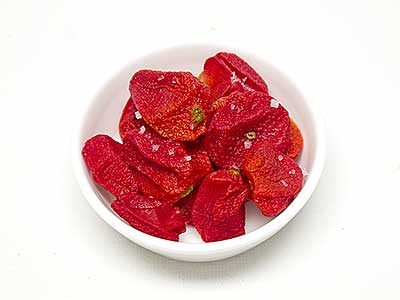December 22, 2014
Amuse-Bouche

tomates demi-secs
(half-dried tomatoes)
Taillevent didn’t write recipes for you or me. Irrespective of the fact that he was writing his recipes in the first half of the prior millennium, or as has been suggested, that he was dictating the recipes since he probably was illiterate, his intended audience was most likely his employer. His purpose was to provide a record of his cooking.
Recipes have taken many forms since Taillevent’s example. His almost shorthand descriptions, over time, gave way to more prescriptive explanations. Modern recipes range from meager to verbose. Some include extensive headnotes that have little if anything to do with the actual recipe. This blog is a prime example of the last type.
In most cases, recipes fail to communicate with a large portion of the population. We are left with the paradox that recipes with limited instructions may not provide sufficient information for a novice cook but be easy for an experienced cook while recipes with detailed instructions may be appropriate for the novice cook but frustrating for the experienced cook.
Do you need an example of a recipe with limited instructions? Here’s a teaser that Hiroo Nagahara provided me a couple of months ago:
Dried tomatoes: 2.7% calcium hydroxide, 3-hour soak. Dehydrate.
After preparing the recipe, I scratched out a more loquacious note in pencil on a piece of scrap paper:
Skinned tomatoes. 2% calcium hydroxide, 6 hrs. Dry. Vacuum pack.
The above is sufficient information for me to repeat the preparation, but you may require more if for no other reason than the fact you haven’t seen and tasted the final product.
large
cherry tomatoes, peeled but not cored
calcium hydroxide
fleur de sel
1. Place the tomatoes in a sealable jar. Fill the jar to the rim with water. Drain the water and measure it’s volume. Prepare a two percent calcium hydroxide solution with the same volume as the drained water. (See note below.) Refill the jar with the solution, and seal it.
2. Place the jar on your countertop for 6 hours. Shake periodically if you have a mind to.
3. Drain the tomatoes and wash a number of times with cool tap water. Dry the now-hardened tomatoes on absorbent paper. Place the tomatoes in a dehydrator. Dry at 57 °C (135 °F) until the outside surface is well shriveled. There will still be some juice in the inside. Wipe off any powder residue that forms on the surface.
4. Vacuum pack the dried tomatoes to semi-rehydrate them.
5. When serving, sprinkle with a little fleur de sel.
Note: To prepare a two percent solution, multiply the volume of the solution in milliliters by 0.02. The answer is the weight in grams of calcium hydroxide that should be added to prepare the solution. Accuracy is not super important since this percentage is still many times the solubility of calcium hydroxide.
© 2014 Peter Hertzmann. All rights reserved.
